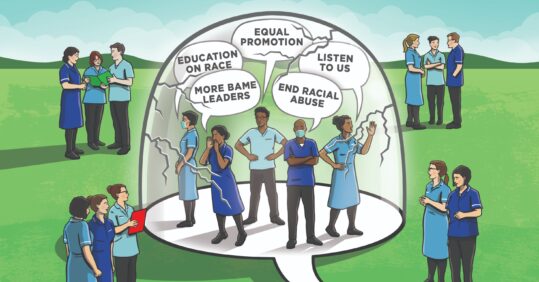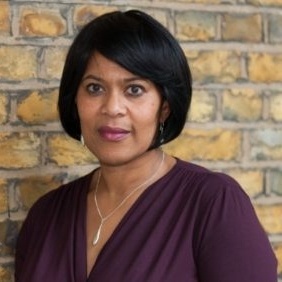Voices of change: speaking up about racial inequality

The Black Lives Matter movement and Covid-19 highlighted the racial inequalities faced by healthcare staff. Mimi Launder looks at the racism suffered by nurses and midwives, and how it is now being tackled.
‘Where’s the other nurse? I don’t want to speak to you. You’re not white.’ The patient’s words hit Robana Hussain-Mills hard as a newly qualified nurse 16 years ago. It was her first job in general practice, a career she had chosen so that she could help people. But she now found some of the people she wanted to care for were rejecting her because of her race. Ms Hussain-Mills says that was not the last time she was on the receiving end of such prejudice.
Sadly, her story is shocking but not unusual. And will almost certainly not be unusual for the 71,648 black, Asian and minority ethnic nurses (BAME) nurses, midwives and health visitors working in the health services in England, making up 20.5% of the workforce, according to 2018 NHS figures.
Studies have shown BAME healthcare staff are more likely to receive verbal or physical abuse from patients or colleagues, are over-represented in lower-paid roles and under-represented at the top, and are more likely to experience formal disciplinary processes. But BAME people have been afraid to speak out in the past. A Public Health England report this summer noted BAME healthcare staff were less likely to ‘speak up’ about concerns, such as their difficulty accessing personal protection equipment, because of ‘historic racism’.
Yet this year, voices talking about racial inequality have been getting louder and are finally being listened to. Events have empowered the BAME communities to speak up: the Black Lives Matter movement, sparked by the killing of George Floyd in the US in May, and the disproportionate impact of Covid-19 on BAME people, which highlighted racial inequalities in the health services.
So what discrimination have BAME health staff suffered and why? And how can the conversation about race be sustained to spearhead change?
Staying silent
Ms Hussain-Mills explains why she kept silent as a newly qualified nurse: ‘I just kept it to myself. [All I could think of was] I don’t want to lose my job’.

Ms Hussain-Mills is not alone. Zeenath Uddin, head of quality and safety at the Royal College of Midwifery (RCM), experienced racism throughout her midwifery career as a Muslim of Asian descent, including patients calling her ‘a Paki’ and a ‘terrorist’, but said nothing for years.
She recalls: ‘Once, I was spoken to in a very derogatory and racist manner by a colleague. A lawyer who overheard said, ‘That’s absolutely appalling. Take my number. You should take it further’. I remember looking at the number and throwing it away because of the fear of reprisal. It’s almost like career suicide.’
Now, Ms Uddin is leading the RCM’s Race Matters campaign, which aims to tackle racism in midwifery and find answers to why black women in the UK are five times more likely to die in childbirth than white women. She continues: ‘I kept silent at the time but silence is not the answer. There are processes you can go through – through your line manager, your lecturer, somebody you trust. As Race Matters campaign lead, I want to be the voice for the voiceless.’
Related Article: How could future nurses use robots to help deliver care?
‘Some BAME people have been told all their lives to keep their head down and not say anything.’
Ms Hussain-Mills has set up the GPN BME network with practice nurse Julie Roye to create a space for BAME nurses to share experiences. She says she has been particularly shocked by ‘horrific stories’ from student nurses that have emerged within the network.
‘A few people were telling us how they were pushed aside as students. They were treated horrendously, had to jump through several obstacles to get something done, and felt more closely watched than their other colleagues.’
Ms Hussain-Mills adds: ‘I don’t want someone newly qualified to come into general practice thinking they can’t speak out. It’s particularly hard in general practice because you are completely on your own, not like on a ward where everyone can hear it.’
Katie (not her real name), a black third-year student nurse from London, says she enters each clinical placement ‘hopeful’ but is continually disappointed: ‘I feel I have to prove more than my white counterparts for lots of reasons – it could be the other individual’s preconceptions before I even open my mouth, wondering whether I am going to be “mouthy” or “hard work”.’
She says there are often few, if any, black senior role models in her placement area and this makes it even harder to say something. But there is more than one obstacle.
‘Many people believe racism does not exist, including some BAME people who have trained their minds not to think about it over many years,’ explains Ms Hussain-Mills.
She adds: ‘Some BAME people have been told all their lives to keep their head down and not say anything. It can be a career-limiting conversation. People have mortgages, bills, cars and a family to feed. They say, “what’s the benefit? Nothing’s going to happen anyway if I speak out”. BAME people also often fear being pinned into racist tropes of being “hard work” or “aggressive”.’

Yvonne Coghill, the outgoing director of NHS England’s Workforce Race Equality Standard (WRES), qualified as a nurse in 1977. She says racism has become more ‘insidious’, which can also mean it’s harder to pinpoint and prove. ‘They’re not shouting and screaming and calling you names and all the rest of it, but they’re working behind the scenes to make sure that we keep the status quo, and things don’t change as quickly as they might.’
Race during Covid-19
A Nursing in Practice survey, published in October, of 40 primary care and community nurses and midwives, found some BAME workers reporting worsening abuse because of Covid-19.
One respondent wrote: ‘I am Chinese. Patients and people in general say that Covid-19 originated from China and that [people of] Chinese descent are culpable for the pandemic.’ A further two respondents also said BAME staff struggled more to access PPE, after an RCN survey found the same in May.
Ms Coghill says Covid-19 has both exposed and worsened existing race inequality. She tells Nursing in Practice: ‘People of colour often work where there’s heavy viral load, such as in nursing and midwifery. Within nursing, they are more likely to be at the lowest band, at the front line.’ This is backed by a Public Health England report from June that found people of Bangladeshi heritage were around twice as likely to die as white groups from Covid-19, while people of Chinese, Indian, Caribbean, African and ‘other black’ ethnicity had between 10 to 50% higher risk of death.
Last month, the Government’s Race Disparity Unit (RDU) found that these disparities were largely due to poverty and social inequality, including factors such as living conditions and occupancy. Figures from the British Medical Association in June showed that although only 21% of all staff were BAME, 63% of healthcare workers who died were from an ethnic group.
‘Imagine if every time you turn on the TV, you are told that you’re going to die. That’s what it feels like.’
BAME workers say this pressure is taking its toll mentally. Katie was testing patients for Covid all day for most of her days on placement, which drove her to quit two weeks early: ‘I had to say “I can’t do this”… I was so paranoid. I had a routine where I wiped down door handles, my steering wheel, everything before I got out of my car. I used my elbow to ring my doorbell for one of my family members to let me in. I immediately got everything in the washing machine.’
Dr Joan Myers, the director and trustee of the Florence Nightingale Foundation and a Queen’s Nurse, says: ‘There will be a lot of traumatised people in the BAME community. Imagine if every time you turn on the TV, you are told that you’re going to die. That’s what it feels like.’
‘A vicious cycle’
Related Article: What we do and don’t know about practice nurses being added to ARRS
‘The NHS is a microcosm of society,’ says Ms Coghill. She explains: ‘The types of people you have in society, you also have working for our NHS. We’re not all the wonderful, touchy-feely, gorgeous, super-sweet, delightful people that the public like to think we are. We have people in our NHS who are downright horrible, who don’t like difference.’
Ingrained inequality shows in the data. The 2019 NHS staff survey flagged that almost a third of minority ethnic staff in England had experienced bullying, harassment or abuse from colleagues in the past year. In addition, they stand on a ‘sticky floor’ when it comes to career progression: WRES data from last year show BAME staff are over-represented at Agenda for Change band 5 and under-represented in higher bands.
BAME staff are also more likely to be disciplined and referred to the Nursing and Midwifery Council (NMC), according to NMC data from 2017.

‘The higher up in the NHS you go, the fewer black faces there are,’ says Sharon Aldridge-Bent, director of leadership nursing programmes at the Queen’s Nursing Institute (QNI). Ms Aldridge-Bent once delivered a workshop for BAME senior leaders trying to become Queen’s Nurses at a central London hospital, as they are under-represented, but found everyone attending was white. When she queried this, ‘someone scurried down the corridor and brought up all the BAME nurses in uniform’. ‘It speaks volumes if you haven’t got any BAME nurses working at senior level in your organisation,’ Ms Aldridge-Bent says.
‘The list goes on and on for nurses and midwives of colour,’ says Ms Coghill. ‘It’s a vicious cycle. If all these awful things happen to you, you get angry but you can’t do anything about it. Anger leaks out of you. So, it becomes a self-fulfilling prophecy that you’re the angry black woman who nobody wants to have in their face.’
Time to listen
‘In a way, Covid-19 has given permission to speak out,’ says Ms Hussain-Mills. ‘I don’t think we’d be talking about race equality as much if it hadn’t happened.’ The BME GPN network is one of the new safe spaces for practice nurses from a BAME background. Ms Coghill says these kinds of ‘safe havens’ are crucial to supporting BAME nurses.
Ms Hussain-Mills advises: ‘It’s about debunking these myths and saying “I’m not aggressive, just passionate”. It’s important to change the language used.’
She explains tackling ingrained prejudices, stereotypes and discriminatory structures is also important. ‘The trick is to learn what race inequality is all about.’
White ‘allyship’ is helpful, especially because white people are disproportionately in positions of power where they can implement change, Ms Hussain-Mills explains.
Ms Coghill has come up with seven steps to ‘authentic allyship’ (see box below).
She explains: ‘At the very end of the steps is action. This could be mentoring somebody, sponsoring somebody, it could be just giving somebody a hand. It could be anything, but that action needs to come only after you’ve done the work to understand why you are taking that action. Being an ally is something you have to do for the long haul, not just five or 10 minutes.’
Related Article: GPN pay: A reflection on the last 12 months
White allies and leaders in the NHS must confront race issues rather than avoid them, agrees Ms Alridge-Bent. She recounts when a white women used the term ‘coloured’ on a course with other NHS leaders and nurses: ‘I was the only black person in the room. No one else spoke up, but I politely said, “We don’t use that term any more”. The white woman was upset and ended up running to the bathroom crying. This behaviour made the other white people feel sorry for her and somehow, I became the awful one for highlighting the term. This made me realise how sensitive people can be when called out.’
Dr Myers argues management needs to be better trained to spot and tackle racism. She welcomes courses for BAME leadership, but argues the structure needs to change too: ‘It’s the people who carry the power in clinical settings who are the most important. They need to be asked to look into the organisation of their teams, and how they can support BAME people to progress.’
Mentoring: seven steps to ‘authentic allyship’
Appetite – Do you have the appetite to immerse yourself in the complex, emotive world of race equality?
Ask – Ask questions about race, be curious, read, learn and educate yourself.
Accept – Accept there is really a problem. More data aren’t needed.
Acknowledge – Openly acknowledge that the problem needs to be dealt with.
Apologise – Express sympathy that racism is affecting people of certain races.
Assume – Don’t. Instead develop informed views by seeking to understand individuals.
Action – Take demonstratable action steps to establish equality and be accountable.
Source: Yvonne Coghill, NHS England Workforce Race Equality Standard (WRES)

See how our symptom tool can help you make better sense of patient presentations
Click here to search a symptom




